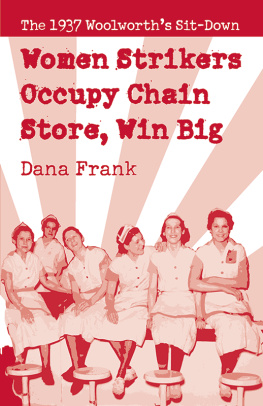Also available from Haymarket Books
Be RealisticDemand the Impossible
by Mike Davis
With wit and a remarkable grasp of the political marginalization of the 99%, Mike Davis crafts a striking defense of the Occupy Wall Street movement. This pamphlet brilliantly undertakes the most pressing question facing the struggle what is to be done next?
Lessons for Our Struggle
by Frances Fox Piven
Frances Fox Piven reminds us why we must understand the labor, civil-rights, and anti-imperialist struggles of the Depression era if we are going to advance the struggles of the present.
A Glance in the Rear View Mirror
Neoliberal Ideology From its Origins to the Present
by Eric Toussaint
As the financial crisis continues to shake the economy it has begun to expose cracks in the ideology long used to justify neoliberal policies. This informed and accessible primer drives a wedge into these cracks, allowing the non-expert to understand the flaws in the economic philosophy of the 1%.
Contents
Originally published in Three Strikes: Miners, Musicians, Salesgirls, and the Fighting Spirit of Labor's Last Century
by Beacon Press, 2001
2001 by Dana Frank
Published 2012 by Haymarket Books
PO Box 180165
Chicago, IL 60618
773-583-7884
www.haymarketbooks.org
info@haymarketbooks.org
Trade Distribution:
In the US, Consortium Book Sales and Distribution, www.cbsd.com
In Canada, Publishers Group Canada, www.pgcbooks.ca
In the UK, Turnaround Publisher Services, www.turnaround-uk.com
In Autralia, Palgrave Macmillan, www.palgravemacmillan.com.au
All other countries, Publishers Group Worldwide, www.pgw.com
ISBN: 978-1-60846-246-9
Library of Congress Cataloging-in-Publication data is available
Interview with Dana Frank
Conducted by Todd Chretien December 12, 2011
Todd Chretien: Id like to ask you about the parallels between the Occupy Wall Street protests and the great workplace occupations carried out by workers in the 1930s in their fight for union rights. So to begin with, Dana, can you speak about the precursors that led up to the occupation at Woolworths? How did working people respond to the Great Depression? What were the movements, the strikes, the organizations that laid the basis for this type of action?
Dana Frank: Lets remember exactly when this strike happened: right in the middle of the Great Depression. The U.S. economy was a total disaster since 1929. At the worst point a third of the country was unemployed and another third was underemployed. But at the same time, by 1937 when the Woolworths strike happened, people had a huge sense of hope because of the New Deal. The government of Franklin Delano Roosevelt had created all sorts of social programs to redistribute wealth and try to address the economic crisis. But lets be clear: the New Deal only happened because ordinary people were taking things into their own hands with huge social protests throughout the 1930s, and thats what got us the welfare state. We tend to think that people just roll over dead when things are terrible economically, but in reality its just the opposite.
The most spectacular of those social movements in the thirties was the uprising of the labor movement through the Congress of Industrial Organizations, the CIO. It organized literally millions of people. Thats when we got most of the big industrial unions that we take for granted, like the auto workers, steel, tire, electrical manufacturing. All of that was happening in 1936 and 1937. The most famous moment was when the auto workers sat down and occupied a General Motors plant in Flint, Michigan, for almost two months. And they beat General Motors cold. There was almost no union in there before, and they won union recognition, wage increases, and then, eventually, better and better contracts at GM.
So, in that winter of December 1936 and January 1937, the General Motors strike was going on in Flint, next door to Detroit, and it was really an astonishing thing. It was all over the headlines in the United States and all over the world for that matter, because GM was the biggest corporation in the world, and the workers completely defeated it. That victory then inspired people to all kinds of labor activism. People said, Wow, if they can beat General Motors, anything can happen! In fact, U.S. Steel, really soon after that, gave in to the Steel Workers Organizing Committee without a strike because it was so afraid the same thing would happen to it, too.
The Woolworth struggle was at this exact moment. These women said, Whoa! It wasnt just them, either. Two or three weeks after the autoworkers won, all these little strikes started breaking out in Detroit and all over the Northeast and upper Midwest, led by workers in laundries, in restaurants, in golf ball factories. They saw that the iron was hot, that there was a window of opportunity for activism. Public opinion was on the side of the General Motors strikers. Public opinion was saying, Wait a minute, something is very wrong in this country. The wealth is completely out of kilter in this country in terms of whos rich and whos poor. Remember, General Motors was a sit-down strike, so the strikers had to have the moral authority and legitimacy to occupy private property and win. You can only do these things when people in the general public are feeling like, They have a right to do this. That winter and spring of 1937 was an incredible, historic moment in U.S. history.
Could you say a few things about this question of seizing or occupying private property? As we know, private property is written into our constitution, it is sacrosanct, and unions have traditionally picketed outside workplaces, workers have withdrawn their labor from companies and corporations as the primary means of taking strike action. So how and why did workers decide to move their strikes inside?
Its important to underscore that these sit-down strikers were not trying to take property away from the owners. They were using a sit-down as a tactic while they were striking. Traditional strikes set up a picket line as big as possible around the workplace and the workers use that to prevent the employers from bringing in scabs. In a sit-down strike, you are already in there so they cant bring in scabs. Also, you have a sense of camaraderie and spirit and creativity, because what are you going to do in there all day, right? But because its on somebody elses property, there are these questions of legitimacy. When people have a sense that the corporation, or whatever the target might be, is itself illegitimate, that its obtained its power and wealth illegitimately, then you can have public opinion on your side. But I do want to emphasize that the strikers were not saying take the store away from Woolworths. They were saying, Give us just wages, shorter hours, dont make us pay for our uniforms. In terms of demands, they were not saying that we should own it. Also, they were super, super careful to never damage a thing inside the store while they were in there.
But the Woolworths strike was about saying, we are going to take our bodies and we are going to put them here and we are going to make some claims. Thats what the Republic Windows and Doors workers did in 2008 in Chicago when they occupied their plant and said, Wait a minute, you cant just shut down this factory without paying us. They were working with the United Electrical Workers union, and they won, too. So, the sit-down is a tactic, its about people thinking creatively about what it means to occupy something. Notions of property can shift during moments of fundamental economic crisis, such as the one were in now. When the system isnt working, people start rethinking it; they challenge whats just and whats not.
Next page










